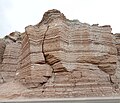Description
The formation consists of up to 100 meters (330 ft) of red mudstone, with thin interbeds of green and red sandstone. The lower portion of the formation shows polygonal desiccation cracks and localized salt-hopper casts while the upper portion contains considerable gypsum, consistent with deposition in a sabkha on the margin of the Sundance Sea.It is exposed in the San Rafael Reef, the Waterpocket Fold, in the Henry Mountains, with additional exposures scattered across the region from the San Rafael Reef to the Paradox Basin, [2] and in north-central New Mexico. [3] The thin bedding is characteristic throughout the formation, but gypsum is not found in the San Juan Basin and some conglomerate is found on the south and southwestern margins of the formation. [4] The correlation of late Jurassic beds in northwestern New Mexico with the Summerville Formation in Utah has been questioned, and it has been suggested that they be assigned to the Beclabito Formation instead. [5]
The Summerville Formation rests conformably on the underlying Curtis Formation (Utah and western Colorado) or Todilto Formation (southwest Colorado and New Mexico) but is separated from the overlying Morrison Formation by the regional J5 unconformity. [1] It thins significantly in the Moab-La Sal area, the likely area of the divide between the marine Curtis basin to the northwest and the salina lake Todilto basin to the southeast. Here the formation is just 1.2 meters (3.9 feet) thick and rests directly on Entrada Sandstone. In many locations the Summerville is separated from the Morrison by eolian sandstones, such as the Bluff Sandstone, variously assigned to the Morrison Formation or the San Rafael Group. The Morrison Formation represents a return to more humid conditions with increased clastic input. [6]
The Bell Ranch Formation of northeastern New Mexico is correlative with the Summerville Formation. [7]
The Summerville Formation is interpreted as recording a regression of the Sundance Sea to the north, with simultaneous infilling of both the Curtis and Todilto basins. This produced a depositional environment of very low relief, in which occasional encroachments of eolian sand during times of drought were subsequently worked into thin strata by wave action in ephemeral saline lakes. [6]
Evenly bedded Summerville Formation exposed along Utah Highway 24, 2.4 miles west of Hanksville, Utah
Closeup of the Summerville Formation showing even bedding, 2.4 miles west of Hanksville, Utah.
Summerville Formation with gypsum-filled cracks. U.S. quarter dollar (24 mm) for scale
This page is based on this
Wikipedia article Text is available under the
CC BY-SA 4.0 license; additional terms may apply.
Images, videos and audio are available under their respective licenses.




